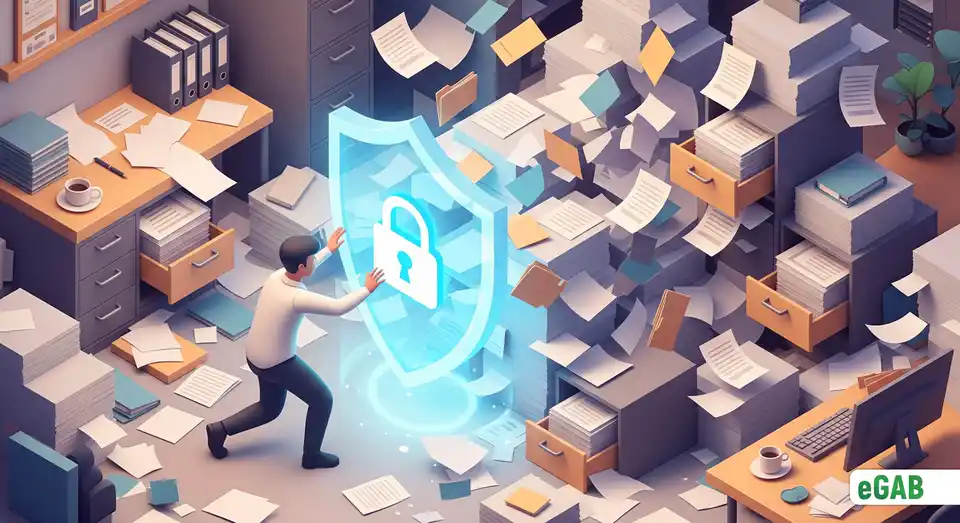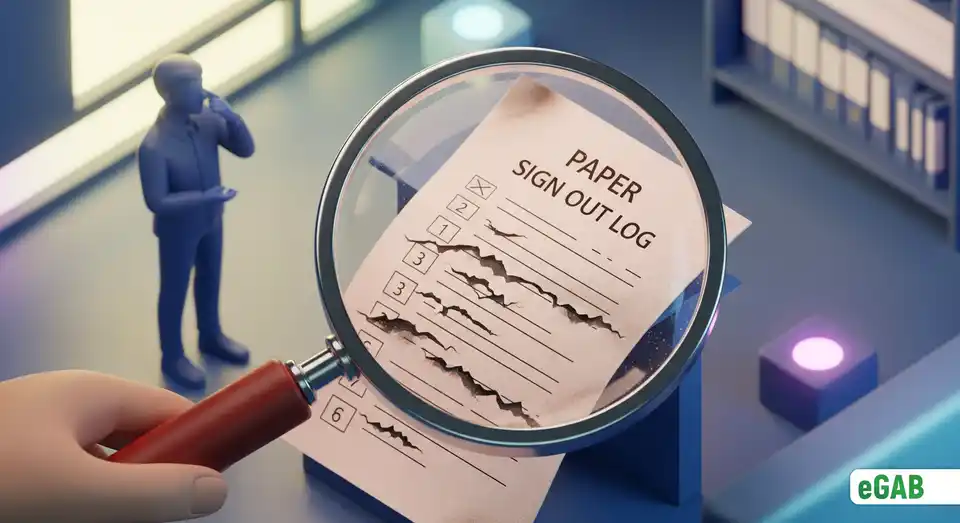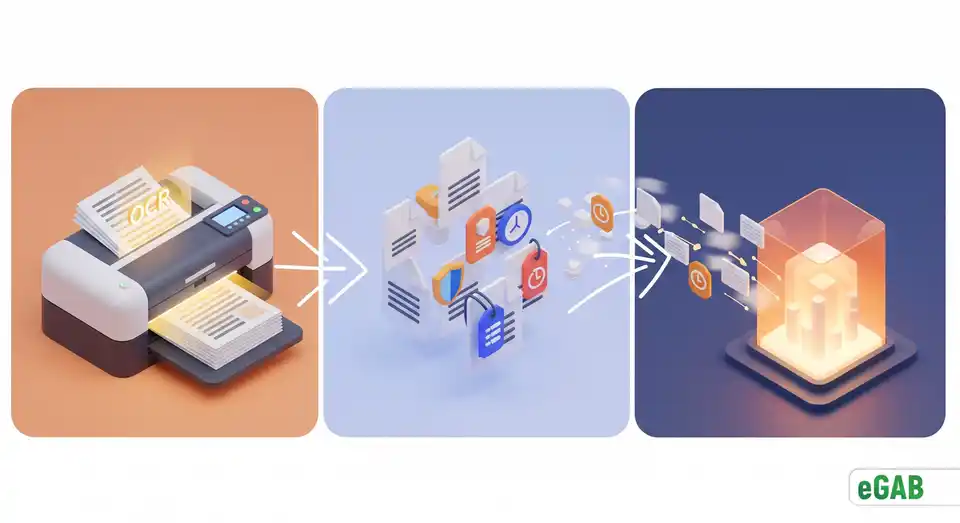Are Your Paper Archives a Legal Time Bomb? Understanding GDPR and Data Retention

 Author:
Artem Grigoriev
Author:
Artem Grigoriev
- Why Is Complying with GDPR and Privacy Laws Impossible with Paper?
- How Do Paper Records Undermine Data Retention Policies?
- Can Your Paper Audit Trail Withstand Legal Scrutiny?
- How Do You Transition from Paper Risk to Digital Compliance?
- What Are the Business Advantages of Going Digital?
- How eGAB Solves GDPR and Data Retention Compliance
- Summary: Turning Your Paper Archive from a Liability into a Strategic Asset
Those towering filing cabinets and dusty storage boxes in the corner? They aren't just holding old paperwork. They're holding a ticking legal time bomb, a direct consequence of inadequate secure document storage. In our age of strict data privacy, this is a serious problem, as every document containing personal information represents one of the critical data security risks of paper documents and a potential compliance failure.
The simple truth is, relying on paper makes it nearly impossible to comply. Modern regulations like the General Data Protection Regulation (GDPR) are demanding. You have to find, manage, and prove the secure deletion of data. And you need to do it all with speed and accuracy.
This article will walk you through exactly why your paper records are such a profound legal risk. We'll explore everything from unmanageable data retention policies to audit trails that simply can't withstand scrutiny. Ultimately, we'll provide a clear roadmap for making the essential switch from physical liability to secure digital compliance.
📘 This post is part of our comprehensive guide to "The Problems with Paper Documents: A Complete Guide". Explore it to find answers to all your questions ;)
Why Is Complying with GDPR and Privacy Laws Impossible with Paper?
Have you ever felt that sinking feeling, digging through years of paperwork for one specific piece of information? It’s frustrating on a normal day. Now, imagine you have just one month to find every single piece of that info, or you’ll face a catastrophic fine. So, why are paper archives a risk under GDPR? Because at their core, the frameworks for GDPR and paper documents are completely incompatible. Under GDPR, this exact scenario is called a Data Subject Access Request (DSAR) . Let's be honest: with a paper-based system, it’s a logistical nightmare that serves as the ultimate bottleneck for business automation and makes real compliance impossible. The real question is, how do you handle a DSAR with paper-based records when accuracy is everything and the clock is ticking?
GDPR gives people powerful rights, but your old-school paper archives make honoring them incredibly difficult. This is the heart of the challenge with GDPR compliance for paper records . Take the "right of access." When you get a Data Subject Access Request (DSAR) for paper files , you can't just find the data; you have to provide it in a "common electronic, machine-readable format." Simply put, a stack of photocopies won't cut it. Then there's the "right to erasure," often called the "right to be forgotten." Trying to fulfill the right to erasure for paper documents is a high-stakes gamble. How can you possibly guarantee you've found and securely destroyed every copy of someone's data when, without a disaster-proof document strategy, a file could be misplaced, duplicated, or sitting on a forgotten shelf? This makes the process unreliable and, more importantly, completely unverifiable. It's the same broken process for the "right to rectification" (an individual's right to have inaccurate data corrected), because manually finding and updating every single physical file is inefficient and notoriously error-prone. For a complete overview of these obligations, you can check the official EU site outlining the Rights for citizens .
Beyond these rights, paper documents have another massive flaw: they completely lack the detailed
access controls
and
auditable trails
that modern privacy laws like GDPR and HIPAA demand. Since there's no practical way to create an automated log for paper, you simply can't prove that unauthorized staff didn't view or handle sensitive personal data. This vulnerability massively increases the risk of a
data breach
. The consequences for getting this wrong are severe. Under GDPR, fines can skyrocket to
€20 million
or
4%
of your company's global annual turnover-whichever is higher. This all leads to one critical question:
can you be fully GDPR compliant while using paper files?
For any organization that's serious about data protection, the answer is a clear and resounding no. Suddenly, those old filing cabinets aren't just storing paper; they're storing an incredible amount of legal and financial risk.
Why It Matters: GDPR compliance is non-negotiable, and relying on paper makes it a losing battle. Because you can't produce a clean, verifiable audit trail, you can't prove you've handled data responsibly to regulators. The risk isn't just about the money; it's a fundamental breach of the trust that your customers and employees place in you.

How Do Paper Records Undermine Data Retention Policies?
What is a data retention policy and why is it so important? It’s the set of foundational rules governing the lifecycle of information in your organization. Every business has to follow rules that dictate exactly how long specific documents must be kept. This brings up a critical question: how long do you legally have to keep business documents? For example, you might need to hold onto tax documentation for 7-10 years , while certain employment records or health and safety files could be required for decades. Juggling these complex and often overlapping data retention schedules for business is a huge challenge for any organization. But with paper archives, it becomes a nearly impossible tightrope walk.
The heart of the problem is a direct violation of the GDPR's core principle of "storage limitation" -the rule that data shouldn't be kept longer than necessary. This principle is crystal clear: you must keep personal data "for no longer than is necessary" for the purposes you originally processed it for. The goal here is to achieve consistent data retention policy compliance . Systematically enforcing this with paper archives is incredibly difficult, which creates two massive risks. On one hand, you risk illegally keeping data for far too long. Every single day you hold onto a document past its legal expiration date, you're increasing your liability and racking up storage costs. On the other hand, you face the very real danger of destroying something too soon. As the ICO's guidance on the Storage Limitation principle makes clear, you could face severe penalties and major legal headaches if you shred a document that's legally required for an audit.
Without an automated system, the entire process relies on manual tracking and human intervention -meaning people have to do everything by hand. You're essentially counting on someone to check a spreadsheet, drive to a warehouse, find the right box, and then get rid of it correctly, all while following a secure document destruction policy that's often poorly enforced. This method is not only prone to error and inconsistent, but it also depends entirely on human memory. This operational mess leads to a chaotic mix of documents, where some are kept too long and others aren't kept long enough. Because paper systems can't send automatic alerts, they can't proactively flag documents for review or destruction. This fundamental weakness turns proactive compliance into a high-stakes guessing game.
Quick Insight: Think of your data retention policy like the expiration dates on food in your fridge. Keeping data too long can make it legally "toxic," dramatically increasing your risk. A manual, paper-based system gives you no reliable way to check those dates, leaving you dangerously exposed.

Can Your Paper Audit Trail Withstand Legal Scrutiny?
Imagine this scenario: you're in the middle of a tense legal dispute. The opposing lawyer demands proof of who accessed a critical document three years ago, on what exact date, and for what specific reason. These paper archives legal risks are where theory hits a painful reality. If you're using a paper-based system, what can you show them? A dusty sign-out log filled with illegible handwriting and missing entries? This is the exact moment the weakness of a paper audit trail (a manual log of who has handled a document) becomes a major liability. It can even lead to serious accusations that you've tampered with the evidence.
Let's be blunt: paper systems fundamentally fail to provide a reliable, unchangeable audit trail. So, what are the main problems with a paper audit trail? There's simply no automatic, immutable log (a record that cannot be changed or deleted) to show who accessed, modified, copied, or even moved a document. For any Compliance Officer tasked with proving responsible data handling, this is a nightmare. Relying on such flimsy evidence in a legal fight is a weak defense, as things like sign-out sheets or someone’s memory just can't provide a defensible record of activity. What's more, with paper records, proving an unbroken "chain of custody" -a core legal principle that shows a piece of evidence hasn't been tampered with-is nearly impossible. So how do you prove chain of custody for a paper document when it has passed through countless hands with no verifiable tracking? You can't.
This critical weakness seeps into and compromises every formal review process you face. For instance, during a legal or tax audit, how can you definitively prove a document's integrity or show its complete history? It could have been easily misplaced, altered, or even subject to modern document forgery without leaving a single trace. The very process of finding the necessary documents becomes a liability in itself. Responding to legal discovery requests (formal demands in a lawsuit to provide relevant documents) and eDiscovery processes turns into a slow, expensive, and often incomplete ordeal. This requires entire teams to manually sift through mountains of paper, all while desperately hoping they don't miss a crucial file.
Takeaway: When you're facing a legal challenge, the burden of proof is squarely on you. A paper trail is an open invitation for scrutiny and doubt. A digital, unchangeable audit log isn't just a nice-to-have feature; it's your best defense, providing a clear, chronological history that can actually stand up in court.

How Do You Transition from Paper Risk to Digital Compliance?
So, how do you ditch the massive risks that come with paper? This transition isn't about just scanning your documents and hoping for the best. Instead, a smart move to digital compliance requires a clear, step-by-step plan-one that transforms your archive from a liability into a secure, manageable, and legally solid asset. The goal is to build a complete program of information governance .
Your journey always starts with intelligent digitization , the first strategic step in transitioning from paper to digital records . This means you'll scan your paper archives using Optical Character Recognition (OCR) technology -software that actually "reads" the text from an image and makes it searchable. This is a game-changing step because it makes the content of your documents as easy to find as a Google search. You can then add digital metadata tags (descriptive labels like keywords or dates) that align directly with GDPR categories, such as "financial record" or "employee data," letting you instantly classify, find, and manage information in seconds.
Many people wonder, can scanned documents legally replace original paper copies? Absolutely, but only if you handle the process correctly. To ensure your new digital copies are legally valid and admissible in court, the entire process must follow recognized frameworks, like the ISO 15489-1:2016 standard for records management , which specifically establishes the legal admissibility of scanned documents .
Next, you need to implement automated retention workflows . So, how do you manage document retention schedules automatically? A modern document management system (DMS) can use a policy engine (a tool that enforces rules automatically) to flag records for review or destruction the moment their legal retention period is up. This powerful automation completely removes human error from the equation. To securely close the loop, the system generates immutable destruction certificates , which are official, unchangeable records proving a document was destroyed. This gives you concrete, verifiable proof that you've complied with every data disposal requirement.
The ultimate result is a centralized digital repository -a single, secure, electronic location for all your documents. This powerful asset empowers you to respond to Data Subject Access Requests (DSARs) with incredible speed and accuracy, making it easy to meet that mandatory 30-day window. When you're looking for a platform, be sure to prioritize a document management system that has built-in compliance features, including granular access controls (highly specific permissions for who can view or edit data), automated policy enforcement, and detailed, unalterable audit logs.
Next Step: Don't try to boil the ocean. Instead, start small but think big. Identify one high-risk, document-heavy department-like HR or Finance-and launch a pilot project to digitize their archive. This strategy lets you perfect your process, demonstrate the clear value of digital compliance, and build momentum for a full organizational transition.

What Are the Business Advantages of Going Digital?
While avoiding legal risks is a powerful motivator, that's not the whole story. So, what are the business benefits of switching from paper to digital? Making the strategic move from paper to a digitally governed system unlocks a host of advantages that deliver a significant return on your investment -meaning the benefits are well worth the cost. This transition isn't just about dodging penalties; it’s about building a smarter, faster, and more trusted organization.
The first win you'll notice is financial. When you overcome the challenges associated with the true cost of paper, you get direct cost savings. Migrating to a digital system dramatically slashes your physical storage costs, with potential savings of up to 80% . Just think about all the valuable office real estate and off-site warehouse space you could free up, directly addressing the real estate cost of document storage. A true paperless office isn't a distant dream anymore-it's a tangible financial goal you can hit. But the savings don't stop there. A fully searchable digital archive also makes your internal workflows fly. For example, industry analysis by AIIM (the Association for Intelligent Information Management) shows that organizations can boost their process productivity by over 30% simply by digitizing their paper systems. A task that once took hours-a perfect subject for a productivity analysis-can now be finished in seconds, putting critical information right at your team's fingertips and streamlining decision-making.
This newfound efficiency creates a powerful ripple effect across your business. The debate over paper vs digital compliance ends here; digital is clearly better. By showing you have robust and compliant data handling practices, you’ll significantly boost the trust of your customers, partners, and regulators-which isn't just good ethics, but a powerful competitive advantage. On top of that, your data security becomes fundamentally stronger. Centralized monitoring, combined with modern tools like encryption and granular access controls, protects your most sensitive information from all threats, both internal and external.
Ultimately, the operational agility you gain-the ability to adapt and respond to changes quickly-is a game-changer. You can cut your response times for legal requests, audits, and DSARs from weeks down to mere minutes. This efficiency not only minimizes labor costs but also virtually eliminates the risk of being hit with penalties for delays.
Did You Know? The benefits go straight to your bottom line. Companies that fully embrace digital transformation do more than just strengthen compliance. They are also far more likely to see increased profitability and market share. It’s a strategic move that pays dividends across the entire business.

How eGAB Solves GDPR and Data Retention Compliance
Trying to navigate data privacy laws like GDPR with a paper-based archive is a compliance nightmare. How do you actually honor the "right to be forgotten" when you can't be sure you've found every physical copy of a person's data? How can you provide a verifiable audit trail when there's no digital log of who touched a file? eGAB gives you a robust and elegant framework to solve these exact challenges.
First, it offers a powerful framework for compliance by giving individuals Self-Sovereign Identity -true ownership and control over their own personal documents. This directly fulfills the core principles of GDPR by putting the user in charge of their data. The platform also allows for detailed, programmable data retention policies. You can have access to documents automatically revoked after a set period, ensuring you can easily comply with "right to be forgotten" requests and data minimization rules.
Finally, every important action-from issuance and sharing to verification and revocation-is recorded, creating an immutable audit trail. This provides regulators with irrefutable, cryptographic proof of your organization's data handling and compliance activities. You can turn a major legal risk into a demonstrable strength.
Did You Know? Under GDPR , not being able to find a person's data is just as much of a violation as losing it. An intelligent, searchable digital system like eGAB is the only way to ensure you can meet data access and erasure requests with the speed and certainty the law demands.

Summary: Turning Your Paper Archive from a Liability into a Strategic Asset
So, where does this leave you? Let's be frank. In today's world of data privacy, your paper archives aren't just inefficient-they're a significant legal and financial liability waiting to happen. As we've covered, relying on paper makes it impossible to meet key legal demands, especially for crucial laws like GDPR. For instance, fulfilling a Data Subject Access Request (DSAR) becomes a frantic, error-prone scavenger hunt through endless files. And honoring the "right to erasure"? That's an unverifiable guess, at best.
What's more, paper-based systems completely undermine your data retention policy compliance . Without automated controls, you're walking a dangerous tightrope. You're caught between illegally keeping data for too long and prematurely destroying records you’re legally required to hold. When legal scrutiny inevitably comes, your defense is weak. The flimsy, unreliable nature of a paper audit trail offers practically no protection, leaving you completely exposed during official audits or damaging legal disputes.
However, the path forward isn't just about avoiding risk; it's about seizing a powerful strategic opportunity. The transition from paper to digital, when done right, is transformative. It turns this vulnerability into a powerful asset. It all starts with intelligent digitization , a process that uses OCR technology to create searchable, classifiable records. It continues by ensuring the legal admissibility of scanned documents , which you achieve by following established standards like ISO 15489-1:2016.
From there, you implement robust automated retention workflows within a modern document management system. This system automatically enforces your policies, removing the risk of human error. It also provides immutable destruction certificates that serve as undeniable proof of compliance. The end result is a secure, centralized digital repository that not only makes you fully compliant but also unlocks significant business advantages.
You'll slash hefty storage costs, boost team productivity, and enhance customer trust. Plus, you’ll gain the operational agility to respond to any request in mere minutes instead of agonizing weeks. Ultimately, moving beyond paper isn't just a defensive chore. It’s a proactive, intelligent investment in building a more efficient, secure, and resilient organization for the future.
➡️ So, what can you do now? Understanding the legal risks often prompts immediate action. Move from chaos to clarity with our guide to organizing your filing system.

What Are Verifiable Documents? A Beginner's Guide to the Future of Trust
Why Public NFT Platforms Are the Wrong Choice for Academic Credentials
Why an In-House Credential Verification System Is a Mistake for Universities
The Anatomy of a Fake: A Deep Dive into Modern Document Forgery
Verifying International Diplomas: Why It’s Broken and How to Fix It
